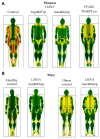Clinical Spectrum of LMNA-Associated Type 2 Familial Partial Lipodystrophy: A Systematic Review
- PMID: 36899861
- PMCID: PMC10000975
- DOI: 10.3390/cells12050725
Clinical Spectrum of LMNA-Associated Type 2 Familial Partial Lipodystrophy: A Systematic Review
Abstract
Type 2 familial partial lipodystrophy (FPLD2) is a laminopathic lipodystrophy due to pathogenic variants in the LMNA gene. Its rarity implies that it is not well-known. The aim of this review was to explore the published data regarding the clinical characterisation of this syndrome in order to better describe FPLD2. For this purpose, a systematic review through a search on PubMed until December 2022 was conducted and the references of the retrieved articles were also screened. A total of 113 articles were included. FPLD2 is characterised by the loss of fat starting around puberty in women, affecting limbs and trunk, and its accumulation in the face, neck and abdominal viscera. This adipose tissue dysfunction conditions the development of metabolic complications associated with insulin resistance, such as diabetes, dyslipidaemia, fatty liver disease, cardiovascular disease, and reproductive disorders. However, a great degree of phenotypical variability has been described. Therapeutic approaches are directed towards the associated comorbidities, and recent treatment modalities have been explored. A comprehensive comparison between FPLD2 and other FPLD subtypes can also be found in the present review. This review aimed to contribute towards augmenting knowledge of the natural history of FPLD2 by bringing together the main clinical research in this field.
Keywords: Dunnigan disease; FPLD2; LMNA; laminopathies; type 2 familial partial lipodystrophy.
Conflict of interest statement
D.A.-V. has received honoraria as scientific advisor from Amryt Pharma. The rest of the authors declare no conflict of interest.
Figures




References
-
- Cabanillas R., Cadiñanos J., Villameytide J.A., Pérez M., Longo J., Richard J.M., Álvarez R., Durán N.S., Illán R., González D.J., et al. Néstor-Guillermo progeria syndrome: A novel premature aging condition with early onset and chronic development caused by BANF1 mutations. Am. J. Med. Genet. A. 2011;155A:2617–2625. doi: 10.1002/ajmg.a.34249. - DOI - PubMed
-
- Garg A., Peshock R.M., Fleckenstein J.L. Adipose tissue distribution pattern in patients with familial partial lipodystrophy (Dunnigan variety) J. Clin. Endocrinol. Metab. 1999;84:170–174. - PubMed
-
- Garg A. Gender differences in the prevalence of metabolic complications in familial partial lipodystrophy (Dunnigan variety) J. Clin. Endocrinol. Metab. 2000;85:1776–1782. - PubMed
Publication types
MeSH terms
Substances
LinkOut - more resources
Full Text Sources
Miscellaneous

